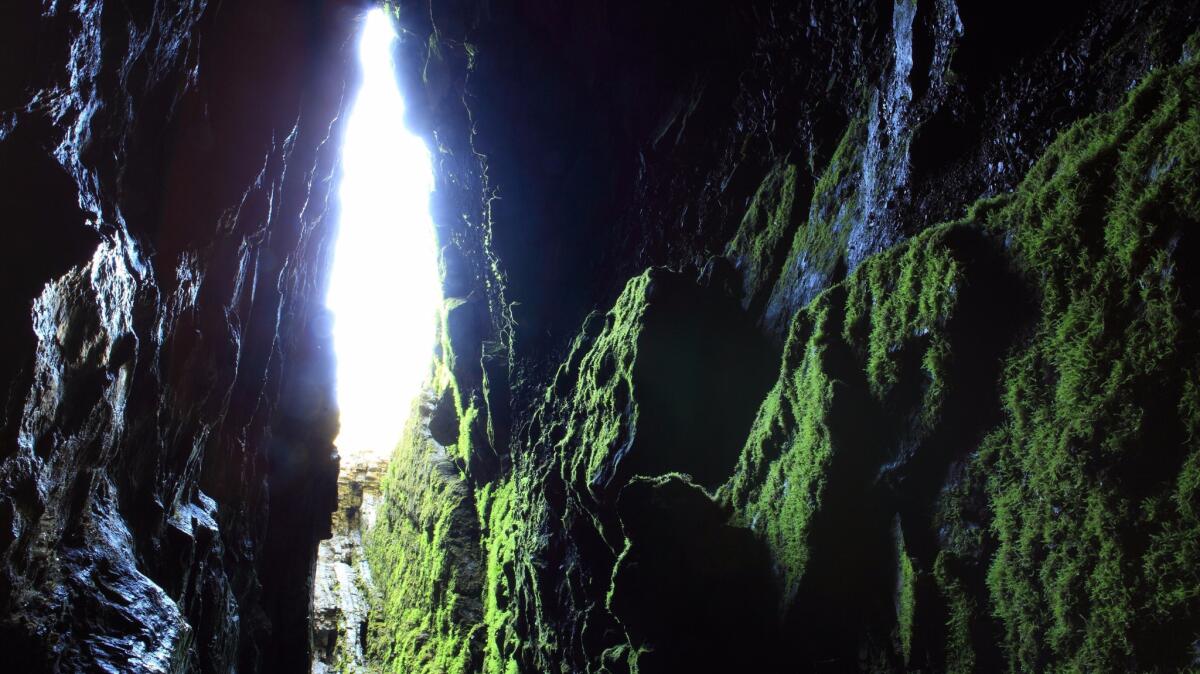More places to see before you die: 21 new sites, from cliffs to caves, added to World Heritage List
Fossil-rich cliffs in Canada from 500 million years ago, sea caves used by Neanderthals, 99 artificial islands in the remote Pacific Ocean and 17 structures designed by the French-Swiss architect Le Corbusier are among 21 new sites inscribed on the World Heritage List.
The additions include two sites each in China, India and Iran, and give the Caribbean nation of Antigua and Barbuda its first site on the list, a historic dockyard.
The additions were made by UNESCO’s World Heritage Committee, which opened its annual meeting in Istanbul last week. The gathering was supposed to continue through Wednesday, but was cut short by an attempted coup in Turkey. Still, delegates managed to finish their business of making additions to the list, which now totals 1,052 sites.
Inclusion on the list can provide a huge boost to tourism but also puts pressure on governments to preserve and protect the sites in question. In addition to designating new World Heritage Sites, the committee also added sites in Mali, Uzbekistan, Libya and Micronesia to its List of World Heritage in Danger, a tally of places facing grave threats from conflict, neglect, over-development and other forces.
To be chosen for the World Heritage List, sites are to be “of outstanding universal value” and meet at least one out of 10 other selection criteria, among them that they “represent a masterpiece of human creative genius” or “contain superlative natural phenomena or areas of exceptional natural beauty and aesthetic importance.”
Here’s a look at the new sites and why they were selected:
China: Hubei Shennongjia

The largest primary forest remaining in central China, this area is home to many rare animals including the Chinese giant salamander, the golden or snub-nosed monkey, the clouded leopard, common leopard and the Asian black bear. The area was the focus of international plant collecting expeditions in the 19th and 20th centuries.
China: Zuojiang Huashan rock art landscape
Thirty-eight sites of rock art in southwest China dating from the 5th century BCE that illustrate the life and rituals of the Luoyue people; these are the only remains of this culture today.
Architectural works of Le Corbusier
This “site” is actually 17 structures in seven countries designed by the modernist Swiss-born French architect Charles-Edouard Jeanneret-Gris, better known as Le Corbusier. The structures, including a chapel, a museum and a home, are in India, Japan, Argentina, France, Belgium, Germany and Switzerland.
Le Corbusier, born in 1887, built mainly with steel and reinforced concrete, employing geometric forms. The buildings, the committee said, “are a testimonial to the invention of a new architectural language that made a break with the past.”
Le Corbusier died in 1965. “These masterpieces of creative genius also attest to the internationalization of architectural practice across the planet,” the panel added.
Canada: Mistaken Point
A 10-mile stretch of rugged cliffs, this area at the southeastern end of Newfoundland contains a large number of fossils from the Edicarean Period that began 580 million years ago. The marine fossils here “illustrate a watershed in the history of life on Earth: the appearance of large, biologically complex organisms, after almost 3 billion years of micro-dominated evolution,” the committee said.
Mexico: Archipiélgo de Revillagigedo
These four islands off Mexico’s Pacific Coast are submerged volcanoes, their peaks poking above sea level. The islands of San Benedicto, Socorro, Roca Partida and Clarió provide habitat for seabirds and the nearby waters have large numbers of whales, sharks, dolphins and manta rays. The islands are southwest of the tip of Baja California Sur, and due west of Mexico City.
Antigua: Naval dockyard and archaeological sites
Becoming the first World Heritage listed area in Antigua and Barbuda, this group of naval buildings was chosen for its historical significance. These Georgian style buildings were constructed by the British navy with the labor of African slaves. The dockyard was built to repair ships and protect the interests of sugar cane growers when European powers were vying for control of the Eastern Caribbean. Antigua is about 150 miles east of Puerto Rico.
Sudan: Two marine national parks
This site is actually two separate areas, one a coral reef called Sanganeb Marine National Park and the other a collection of reefs, beaches, islets, mangroves and seagrass beds known as Dungonab Bay-Mukkawar Island Marine National Park. The area is home to the dugong, a rare marine animal, as well as fish, turtles, birds and sharks.
Iran: The Lut desert
Strong winds sweep across this desert between June and October, tracing massive corrugated ridges known as aeolian yardang. This region, spanning more than 8,000 square miles in Iran’s southeast, also contains extensive stony deserts and dune fields.
Iran: the Persian Qanat
Qanats are sloping below-ground tunnels or channels designed to divert water where it’s needed in settlements in dry regions. These gravity-based engineering works, spanning miles, include rest areas for workers, water reservoirs and watermills. The traditional communal management system is still in place and allows fair and sustainable water sharing and distribution, the committee said. “The qanats provide exceptional testimony to cultural traditions and civilizations in desert areas with an arid climate,” it added.
Brazil: Pampulha Modern Ensemble
Another architectural selection, these culture and leisure structures -- including a casino, a ballroom, a golf yacht club and a church -- were designed by Oscar Niemeyer in conjunction with other artists. They formed the center of a “visionary garden city project” created in 1940. Located at Belo Horizonte, the capital of Minas Gerais state, the buildings were designed around an artificial lake.
The complex includes “bold forms that exploit the plastic potential of concrete, while fusing architecture, landscape design, sculpture and painting into a harmonious whole,” the committee said. “It reflects the influence of local traditions, the Brazilian climate and natural surroundings on the principles of modern architecture.”
India: Khangchendzonga National Park
A Himalayan expanse comprising plains, valleys, lakes, glaciers and snow-capped mountains covered with ancient forests, this park includes the world’s third-highest peak. Indigenous Sikkim people worship caves, rivers, lakes and other natural elements in this region, and they have fused these beliefs with Buddhist practices and concepts.
India: Nalanda University archaeological site
These remains are of the most ancient university of the Indian subcontinent, which was active for some 800 years. The remnants of this monastic and scholarly institution date from the 3rd century BCE and include stupas, shrines, residential and educational buildings. It is closely associated with the development of Buddhism into a major world religion.
Micronesia: Nan Madol Ceremonial Center
These 99 artificial islets off the southeast coast of Pohnpei, southeast of Guam, contain the remains of stone palaces, temples, tombs and homes built between 1200 and 1500. This was the ceremonial center of the Saudeleur dynasty, which ruled the island of Pohnpei. Nan Madol has been called the “Venice of the Pacific” because of its extensive system of canals.
Made of basalt and coral boulder, “the huge scale of the edifices, their technical sophistication and the concentration of megalithic structures bear testimony to complex social and religious practices of the island societies of the period,” the committee said. But the panel also added the area to its list of endangered sites, noting that siltation of waterways is leading to unchecked growth of mangroves and undermining the buildings.
Turkey: Ani archaeological site
A medieval city on the border with Armenia, Ani flourished in the 900 and 1000s when it became the capital of the medieval Armenian kingdom of the Bagratides and profited from control of part of the Silk Road. Later it came under Byzantine, Seljuk, and Georgian rule, but it maintained its status as an important crossroads for merchants. The Mongol invasion and a large earthquake in 1319 marked the start of its decline. Still, Ani “presents a comprehensive overview of the evolution of medieval architecture through examples of almost all the different architectural innovations of the region between the 7th and 13th centuries,” the committee said.
Britain: Gorham’s Cave on Gibraltar
Four caves in the limestone cliffs on the eastern side of the Rock of Gibraltar contain evidence, including rock engravings, of Neanderthal occupation over a span of more than 125,000 years.
“Scientific research on these sites has already contributed substantially to debates about Neanderthal and human evolution,” the committee said. Gibraltar is a British territory off the south coast of Spain at the mouth of the Mediterranean.
Greece: Philippi archaeological site
The remains of this walled city sit on the Via Egnatia, an ancient route linking Europe and Asia. Philippi was founded in 356 BC by the Macedonian King Philip II and developed into a “small Rome” with the establishment of the Roman Empire in the decades following the Battle of Philippi, in 42 BCE. A hundred years later, the city became a Christian center following the visit of the Apostle Paul.
Spain: Antequera Dolmens
Built during the Neolithic and Bronze Age out of large stone blocks, these three megalithic monuments are in Andalusia in southern Spain. These three tombs – the Menga and Viera dolmens and the Tolos of El Romeral “are one of the most remarkable architectural works of European prehistory and one of the most important examples of European Megalithism,” the committee said. They are supplemented by two natural monuments: the Peña de los Enamorados and El Torcal mountain formations.
Iraq: The Ahwar
Comprised of seven sites in Iraq’s rich southern marshlands, this area encompasses three archaeological areas including the cities of Uruk and Ur and four wetland marsh areas. These contain the remains of Sumerian cities and settlements that developed in southern Mesopotamia between the 4th and the 3rd millennium BCE in the marshy delta of the Tigris and Euphrates rivers.
Chad: Ennedi Massif
Designated as a “mixed cultural and natural site,” Ennedi Massif is a sandstone formation sculpted by water and wind erosion over time into a plateau featuring canyons and valleys. Rock and cave paintings and carvings in this region are one of the largest ensembles of rock art in the Sahara.
Trans-boundary site: Western Tien-Shan
Spanning Kazakhstan, Kyrgyzstan and Uzbekistan, the Tien-Shan mountains are very biodiverse, and they are the origin of many fruits grown as crops today. The mountains range from 2,300 feet to more than 14,000 feet.
Trans-boundary site: Medieval tombstones
This “site” includes 30 areas in Bosnia-Herzegovina, Croatia, Montenegro and Serbia that contain cemeteries and regionally distinctive medieval limestone tombstones called stećci. The cemeteries date from the 1100s to the 1500s.
Follow me on Twitter @JulieMakLAT.
ALSO
What’s hot in Japan right now? Los Angeles, circa 1976
In France, a moment of silence for Nice victims and outbursts of anger at officials
Islamic State claims responsibility for German train ax attack
More to Read
Sign up for Essential California
The most important California stories and recommendations in your inbox every morning.
You may occasionally receive promotional content from the Los Angeles Times.











